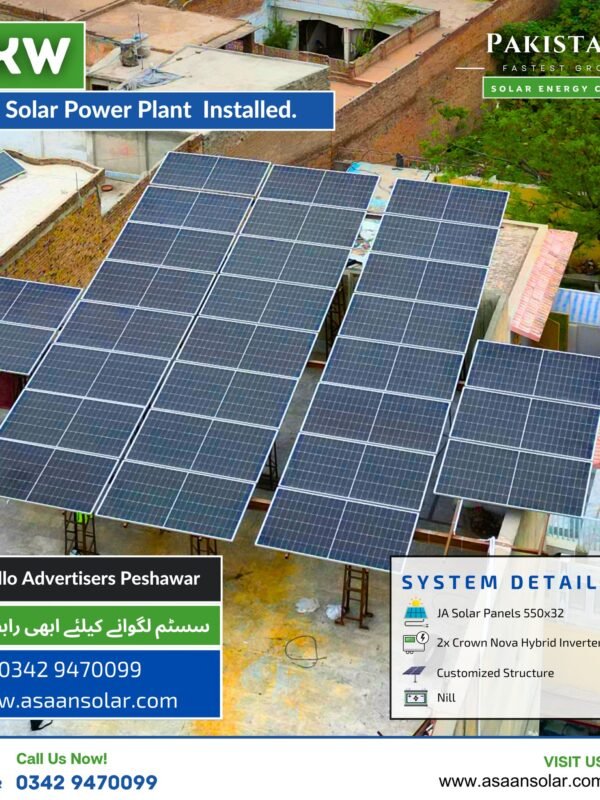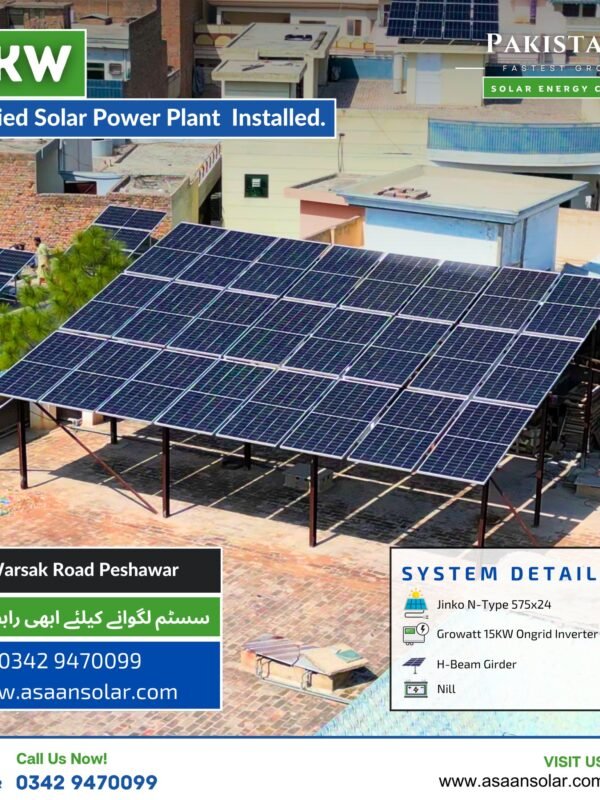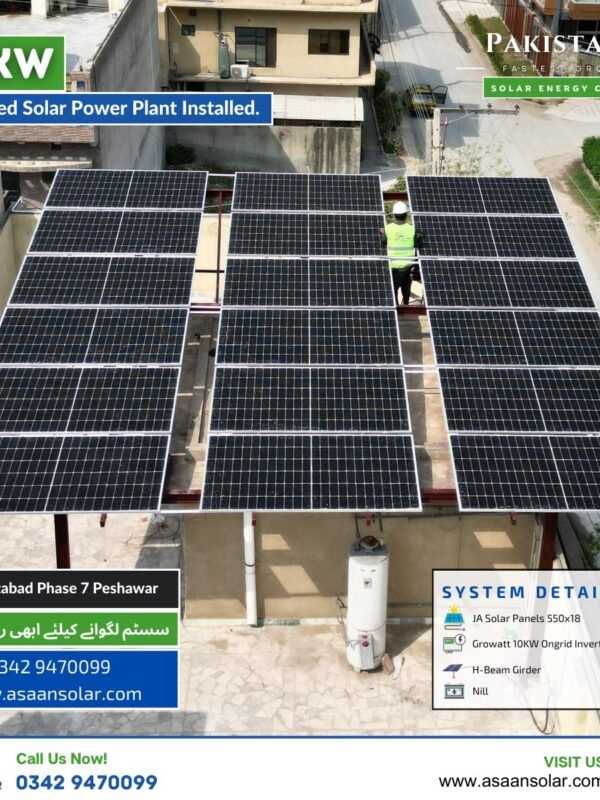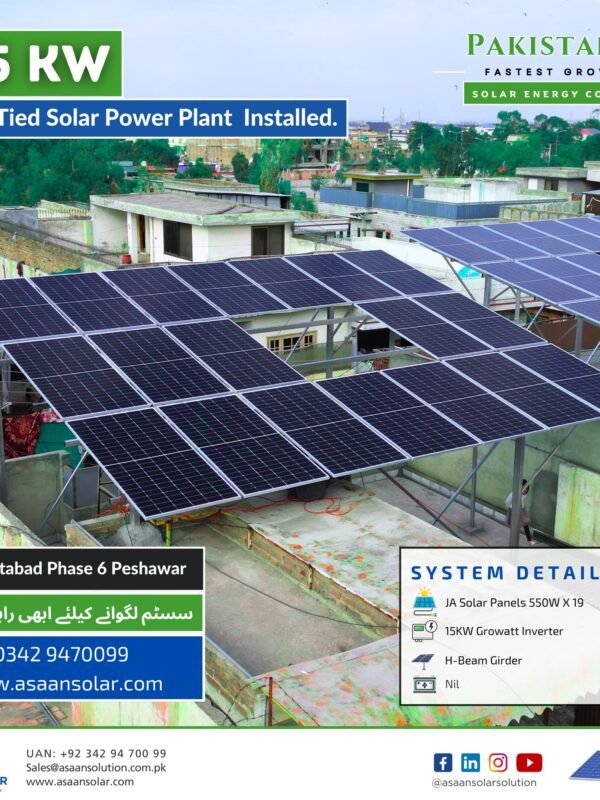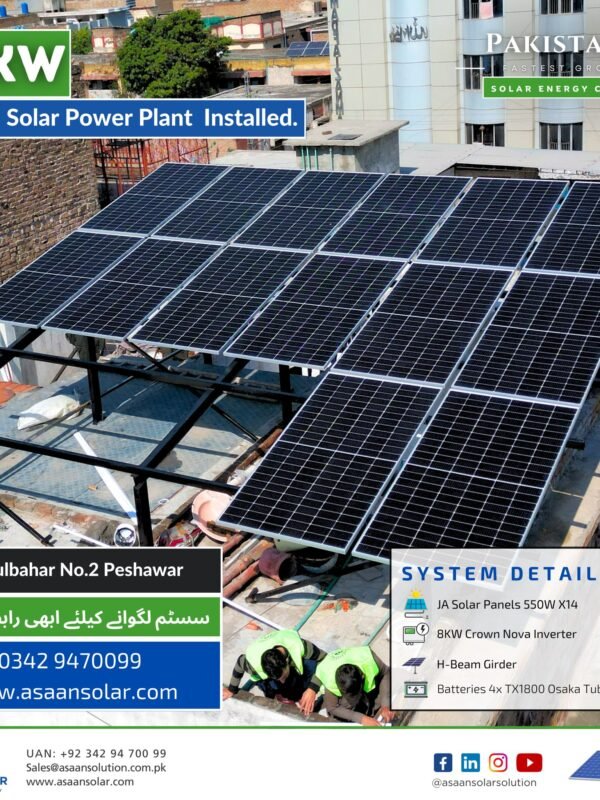Solar Panels in Pakistan
Solar Panels in Pakistan
Best Solar Panels in Pakistan
Usage of Best Solar Panels in Pakistan is on the rise as it is the most effective alternative to conventional energy. In the wake of the energy predicament, several consumers belonging to all sectors have switched to solar panel solutions. These sustainable solar systems ensure energy conservation which makes them a smart option for users. Solar solutions are an automatic choice for clean and renewable energy in our country because it is blessed with sunlight throughout the year. The seamless installation of a turnkey solar solution ends power outages and can bring high electricity bills to zero. Before explaining solar panels’ types and efficiency, it is pertinent to mention that photovoltaic (PV) solar panels are being discussed. Buy the best solar panels in Pakistan from the best solar panel company in Pakistan.
Top 10 Solar Panels in Pakistan:
LONGi
JA
Canadian
Suntech Power
Sunpower
Jinko
ZN Shine
LG
Panasonic
Trina
Types of Solar Panels in Pakistan
The two most common types are Monocrystalline and Polycrystalline. Their PV solar plates feature crystalline silicon cell technology which differs in both types. These counterparts also have some other distinctive variables that give a better overview and influence users’ choices. It includes aesthetics, volume, construction, cost, space efficiency, performance in certain environments, and purity of silicon used in the making. For a better understanding, each of these two types are reviewed in detail below:
Monocrystalline Solar Panels
Monocrystalline solar panels are considered the premium solar product out of these two with relatively high efficiency. These panels are created based on most developed technology being used since ages. Resilient and reliable, the main characteristics of monocrystalline solar panels are explained here.
Construction
As obvious by its name, the monocrystalline solar panels are made from single-crystal silicon. A method termed ‘Czochralski’ is adopted for the formation of large cylindrical-shaped silicon ingots using the drawn technique. These ingots are then sliced from the four sides to make silicon wafers.
Aesthetic
The monocrystalline panels can be distinguished easily with the cut-out edges of the ingots. Other prominent visual highlights of these solar panels are even color and uniform look.
Performance Efficiency
Since the highest grade silicon is used during the construction of monocrystalline solar panels, they yield the highest power outputs. The solar cells composed of single-crystal silicon allow more space for electrons to generate a flow of electricity. On average, this type of solar panels has an efficiency rate of 15-20%.
Space Efficiency
For solar panel installations, the availability of adequate space is highly desirable for both options; on the roof or on the ground. The monocrystalline solar panels are space efficient and require less space as compared to their other counterparts.
Longevity
These solar panels are given a 25-year warranty by the manufacturers which is considered ideal. However, most of the time it lasts much longer beyond the given period.
Performance in Extreme Climatic Conditions
Monocrystalline solar panels tend to perform better in low-light conditions or warm weather as compared to other types.
Polycrystalline Solar Panels
Polycrystalline solar panel also known as multi-crystalline solar panels have comparatively newer technology and was first introduced in 1981. Unlike monocrystalline panels, the Czochralski process is not followed for the making of these panels. Following is a quick review of polycrystalline solar panels.
Construction
The multicrystalline solar panels are developed when many fragments of raw silicon is melted and then cooled down. After cooling, it is sliced into square wafers to form the panel.
Aesthetic
Contrary to monocrystalline panels, these solar panels have perfectly rectangular edges. The solar cells in these panels don’t have uniform appearance as they tend to look in the monocrystalline panels. However, these panels can be easily identified with their distinctive color and prominent graining or speckled outlook.
Performance Efficiency
Polycrystalline solar panels have performance efficiency close to the monocrystalline ones with an efficiency rate ranging from 14-16% on average. As there are many silicon crystals in each solar cell, electrons can’t move much freely resulting in slightly less efficiency.
Space Efficiency
Polycrystalline solar panels can be a suitable option if enough space is available as these panels require larger space. If there is any limitations or space constraints, these panels won’t be a viable choice.
Longevity
As far as longevity is concerned, the polycrystalline solar panels come with 25 yeayearrranty which is good enough. If maintenance is maintained over time, more likely this time duration can exceed.
Performance in Extreme Climatic Conditions
The performance of polycrystalline solar panels suffers in certain climate conditions like snowy weather or low-light situations. As they tend to have lesser heat tolerance, their performance drops as the temperature rises to the peak.
Monocrystalline Solar Panel vs Polycrystalline Solar Panel
| Monocrystalline solar panels | |
| Technology | Single-crystal Silicon Solar Cell |
| Cost | More expensive |
| Efficiency | More efficient |
| Space Efficiency | Requires less space |
| Appearance | Blackish hue, Uniform solar cells, Aesthetically pleasing |
| Longevity | 25+ years, including 25 years Warranty by Manufacturers |
| Major Brands
| Canadian Solar, Sunpower, LG, Hyundai, SolarWorld |
| Polycrystalline solar panels | |
| Technology | Multi-crystalline Solar Cell |
| Cost | Lesser in cost |
| Efficiency | Slightly less efficient |
| Space Efficiency | Requires more space |
| Appearance | Bluish hue, Speckled or Grained |
| Longevity | 25+ years, including 25 years Warranty by Manufacturers |
| Major Brands | Hanwha, Kyocera, Hyundai, SolarWorld, Trina |
Bifacial Solar Panels: Unveiling Enhanced Energy Capture
Bifacial solar panels represent a cutting-edge technology that goes beyond traditional solar panel designs. Unlike conventional panels that capture sunlight only from the front side, bifacial panels have the unique ability to harness energy from both the front and rear sides. This is achieved through the reflection of sunlight off surrounding surfaces, such as the ground or nearby structures.
Advantages:
Increased Energy Yield: Bifacial panels can significantly boost energy generation by capturing sunlight that bounces off surfaces, especially in environments with high albedo.
Versatility in Installation: These panels are adaptable to various settings, including ground-mounted installations and rooftop setups, maximizing their flexibility in diverse solar projects.
Optimized Performance in Certain Environments: Bifacial technology excels in environments with ample reflected light, such as snowy landscapes or areas with light-colored surfaces.
Reduced LCOE (Levelized Cost of Electricity): Despite being a sophisticated technology, bifacial panels can contribute to a lower levelized cost of electricity over the system’s lifetime due to increased energy production.
Investing in bifacial solar panels marks a stride toward improved efficiency and sustainable energy solutions, making them an excellent choice for those seeking to maximize solar power generation.
| Criteria | Monofacial Solar Panels | Bifacial Solar Panels |
| Frontal Sunlight Capture | Captures sunlight only from the front surface. | Captures sunlight from both front and rear sides. |
| Energy Generation | Generates energy primarily from the front side. | Enhances energy generation by utilizing rear-side reflection. |
| Efficiency | Typically lower efficiency compared to bifacial. | Higher efficiency potential due to dual-sided sunlight absorption. |
| Installation | Traditional installation with front-facing setup. | Requires elevated or reflective surfaces for optimal performance. |
| Performance Variability | Susceptible to shading and uneven sunlight. | More tolerant to shading, potentially providing stable output. |
| Cost | Generally lower upfront cost. | May have a higher upfront cost but potentially lower LCOE. |
| Versatility | Suitable for standard ground or roof installations. | Versatile for various environments, including elevated installations. |
| Application Range | Commonly used in standard solar installations. | Suitable for installations where rear-side sunlight is leveraged. |
| Maintenance | Standard maintenance practices apply. | Similar maintenance requirements as monofacial panels. |
| Environmental Impact | Traditional design with standard environmental impact. | Potential for a lower environmental footprint due to increased efficiency. |
Night Solar Panels: Illuminating the Power of the Dark
Night solar panels, a concept on the frontier of solar technology, hold the promise of tapping into solar energy even during the absence of sunlight. While traditional solar panels rely on daylight, night solar panels aim to provide an uninterrupted power supply, making them a potential game-changer in the realm of sustainable energy.
How Night Solar Panels Work:
Photoluminescent Technology: Night solar panels leverage photoluminescent materials that can store sunlight during the day and emit it as light during the night.
Energy Storage Solutions: Coupled with advanced energy storage systems, night solar panels can store excess energy generated during the day for use during nighttime hours.
Potential for Grid Independence: Night solar panels, if successfully developed, could contribute to reducing dependence on the grid, especially during peak demand hours when solar energy is traditionally unavailable.
While night solar panels are still in the experimental stage, they represent a fascinating avenue for research and development in the quest for round-the-clock renewable energy.
P-Type and N-Type Solar Panels: Decoding Semiconductor Variants
In the world of solar energy, the semiconductor material used in solar panels plays a crucial role in determining their efficiency and overall performance. P-type (positive-type) and N-type (negative-type) solar panels represent two prominent semiconductor variants, each with its unique characteristics and impact on the effectiveness of solar cells.
P-Type Solar Panels:
Material Composition: P-type panels are typically made of silicon with added materials like boron. The addition of boron creates “holes” in the silicon lattice, resulting in a positive charge.
Performance: P-type solar panels generally exhibit higher efficiency levels due to the enhanced mobility of positively charged carriers (holes) in the silicon structure.
Applications: Commonly used in conventional solar cells, P-type panels find applications in residential, commercial, and industrial solar installations.
N-Type Solar Panels:
Material Composition: N-type panels use silicon with added materials like phosphorus, creating an excess of negatively charged electrons in the silicon lattice.
Performance: While N-Type panels may have slightly lower efficiency compared to P-Type, they excel in resisting the effects of light-induced degradation (LID), ensuring more stable long-term performance.
Applications: N-type panels are gaining popularity in high-performance solar applications, especially in environments with challenging light conditions.
List of Best Solar Panels in Pakistan:
- LONGi Solar Panels
- JA Solar Panels
- Canadian Solar Panels
- Jinko Solar Panels
- Trina Solar Panels
Solar panels manufactured by different brands are now available in Pakistan. The selection of monocrystalline or polycrystalline solar panels is preconditioned to the customized needs, cost and space availability you have. The choice of a reputed brand is key in this case which offers supreme quality solar plates. Asaan Solar integrates solar panels of top-notch international brands and facilitates their clientele with the finest user experience. Here is a brief introduction of each of these top rated solar panel brands.
JA Solar Panels in Pakistan
JA Manufactures multiple high performance solar modules which are utilized in PV systems for different sectors. Being on top for their durability and reliability, JA Solar Panels in Pakistan are integral part of solar systems or power plants. Get a Quote for JA Solar Panel Price in Pakistan and contribute to a better future.
JA Solar – DeepBlue 3.0 P-Type Panels:
JA Solar’s DeepBlue 3.0 P-Type solar panels represent a state-of-the-art photovoltaic solution featuring P-type monocrystalline cells. The P-Type (passivated emitter rear contact) technology enhances cell efficiency by minimizing electron recombination, resulting in improved overall performance. DeepBlue 3.0 panels are known for their high energy conversion efficiency, durability, and reliability. With an advanced design, these panels are suitable for various solar applications, offering a cost-effective and environmentally friendly energy solution.
JA Solar – DeepBlue 4.0 N-Type Panels:
DeepBlue 4.0 N-Type solar panels from JA Solar showcase cutting-edge technology with N-Type monocrystalline cells. N-type (negative-type) cells offer advantages like higher efficiency, lower degradation rates, and improved temperature coefficients compared to traditional P-type cells. DeepBlue 4.0 panels leverage these benefits to provide enhanced energy yields, making them an ideal choice for residential, commercial, and industrial solar installations. These panels are designed to deliver consistent and reliable performance while contributing to sustainable energy production.
Canadian Solar Panels in Pakistan
Adding diversity to the product range, Asaan Solar imports Canadian Solar Panels in Pakistan and integrates them into the solar solutions. The superior quality of these Canadian Solar PV modules produces the best results in terms of energy output. Get a quote for Canadian Solar Panels Price in Pakistan and contribute to a better future.
TOPBiHiKu7 (Bifacial N-type TOPCon Module):
Canadian Solar’s TOPBiHiKu7 is a high-efficiency bifacial solar module featuring N-Type TOPCon (Tunnel Oxide Passivated Contact) technology. The bifacial design allows the module to capture sunlight from both the front and rear sides, significantly enhancing energy generation. With advanced cell technology and reliable construction, TOPBiHiKu7 modules deliver top-tier performance, making them suitable for a wide range of solar applications. These modules contribute to increased energy yields and are designed for durability and longevity.
TOPBiHiKu6 (N-Type TOPCon Bifacial Module):
TOPBiHiKu6 by Canadian Solar is another bifacial solar module that incorporates N-Type TOPCon technology. As a bifacial module, it efficiently captures sunlight from both sides, optimizing energy production. The N-Type TOPCon design enhances efficiency and reduces degradation over time, ensuring reliable and sustainable energy output. With a focus on performance and durability, TOPBiHiKu6 modules are designed for various solar installations, offering a balance between efficiency and cost-effectiveness.
TOPHiKu6 (N-Type TOPCon Monofacial Module):
Solar’s TOPHiKu6 is an N-Type TOPCon monofacial solar module designed for high efficiency in capturing sunlight from the front side. While it is monofacial, meaning it captures sunlight only from the front, it still leverages N-Type TOPCon technology to achieve superior performance. These modules are suitable for applications where bifacial capture may not be necessary, providing a cost-effective solution without compromising efficiency. TOPHiKu6 modules contribute to sustainable energy production with a focus on durability and consistent output.
LONGi Solar Panels in Pakistan
Asaan Solar is providing efficient, durable, reliable LONGi Solar Panels in Pakistan. We bring the highly innovative solar panels of LONGi to Pakistan at a very reasonable price. Get a quote for LONGi Solar Panel Price in Pakistan and contribute to a better future.
LONGi HiMo 7 (N-Type)
The LONGi HiMo 7 N-Type module epitomizes high-performance solar technology, employing myofascial N-Type solar cells for superior efficiency and durability. Engineered to endure environmental challenges, this module ensures optimal sunlight-to-electricity conversion, meeting the highest industry standards. Versatile and reliable, it is well-suited for various solar applications, contributing to a cleaner and greener future through sustainable energy practices.
LONGi HiMo 6 (P-Type)
The LONGi HiMo 6 P-Type module is another testament to cutting-edge solar innovation, featuring monofacial P-Type solar cells. Renowned for its efficiency and longevity, this module is designed to withstand diverse environmental conditions while delivering consistent energy production. With rigorous testing and adherence to industry standards, the HiMo 6 P-Type module is a reliable choice for residential and commercial solar projects, aligning with the global push toward renewable energy solutions.
SunTech Solar Panels in Pakistan
One of the leading PV manufacturers in the world, Suntech is defined with high quality, reliability, and performance efficiency. It has been quite some time since SunTech Solar Panels in Pakistan have been used in solar solutions. The cost effectiveness of its modules has made it popular in our region.
Sunpower Solar Panels in Pakistan
Buy the best Solar Panels in Pakistan, SunPower is a well-known and top brand in the global solar market and marketing competitive. However installing the best Solar System in Pakistan the and best Solar Panels might seem expensive at first, but one of the ways to invest your money and the best choices for domestic, commercial and industrial sectors. Different modules of Sunpower Solar Panels are now available in Pakistan which are being used by consumers as per their needs. The efficiency of these Solar Panels in Pakistan is par excellence as they provide high energy outputs.
Which Capacity Makes the Best Solar System For Home in Pakistan?
The solar energy systems are available in several capacities irrespective of the system type you are installing. The required capacity of the system depends upon the electricity usage of the consumer. If the electricity usage is higher, the system capacity will be greater as well. The table below will help you find the right capacity for your electricity utilization.
| MONTHLY ELECTRICITY UNITS | SYSTEM CAPACITY |
| 300-350 | 3KW Solar System in Pakistan |
| 500-600 | 5KW Solar System in Pakistan |
| 1100-1200 | 10KW Solar System in Pakistan |
| 1700-1800 | 15KW Solar System in Pakistan |
| 2300-2400 | 20KW Solar System in Pakistan |
| 2800-3000 | 25KW Solar System in Pakistan |
| 3500-3600 | 30KW Solar System in Pakistan |
| 4000-4200 | 35KW Solar System in Pakistan |
ABOUT PRODUCT
Greetings from Asaan Solar, the best source for lithium-ion batteries. Locate superior, environmentally sustainable power options that improve the functionality of your gadgets. Count on Asaan Solar to provide each battery with cutting-edge, eco-friendly, and dependable technology.
Links
- Solar System in Pakistan
- Solar Panels in Pakistan
- Solar Inverters in Pakistan
- Net Metering in Pakistan
CONTACT US
- Phone: (+92) 342 94 700 99
- Email: inof@asaansolar.com
- Office # 15, Peshawar Business Center, Ring Rd Peshawar


